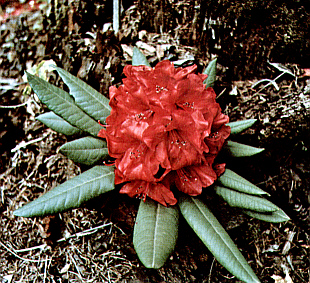QBARS - v29n1 R. 'Captain Jack'
R. 'Captain Jack'
Cecil Smith, Aurora, Oregon

|
|
R. 'Captain Jack'
Photo by Ed Egan |
The late Rudolph Henny made this hybrid by crossing R. eriogynum with 'Mars'. It received a P.A. in 1956.
The following observations are made about the Willamette valley climate south of Portland, where in summer the daytime temperature may go above 90° F fifteen or twenty times during the summer, and where the daytime humidity may go to 20% or even lower, which is much more pleasant for people than for rhododendrons.
The flowers are a bright, dark red, and have a more brilliant color than those of 'Leo' and even a heavier substance. The plant habit and foliage are about average, if certain requirements are met. The leaf color is best in some shade, and the leaves are flatter than they would be in full sun.
There is a lime deficiency in our soil, which is indicated by light green areas between the veins or mottling. An application of agricultural gypsum takes care of that with 'Captain Jack', as with others which have a deficiency problem.
Like most vigorous growers, this plant has a better appearance after a few years if one main trunk is maintained, rather than multiple branches, which have a tendency to settle down and leave an open center. This happens most frequently in shade. These arboreal types will look leggy at first, but later should develop sturdiness and character which no multiple branched plants can ever have. I am not going to attempt, however, to make a tree out of a R. williamsianum .
With care in selecting a planting site, and the right soil ingredients, 'Captain Jack' can have a truss which could be the standard with which to judge other reds, and it can have an acceptable plant habit and foliage appearance
